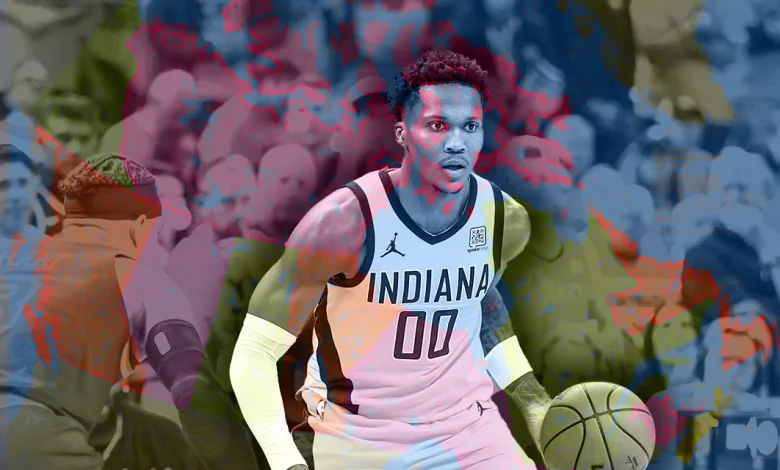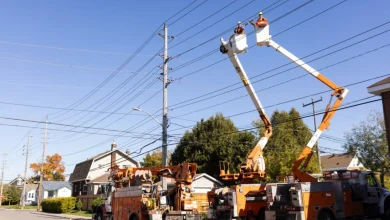Bennedict Mathurin gets buckets in a way none of the other Pacers can

Bennedict Mathurin is scoring at a higher level than all but the best players in the NBA. The fourth-year wing is averaging 26.4 points — 16th in the NBA — on 50.7% shooting from the field and 38.7% from deep while averaging double-digit trips to the foul line.
Small sample size theater, of course, as he has only played five games. And let us acknowledge that the absence of Tyrese Haliburton plays a role, but this style of play isn’t entirely different from his play a year ago.
Mathurin has had his struggles fitting in over his time with the Pacers and being as productive as he has been this season, as a so-so Finals performance was highlighted by a 27-point outing in Game 3 and 24 in Game 7 after Haliburton’s injury. It was also low-lighted by a trio of single-digit scoring games against the Oklahoma City Thunder.
But what we are seeing from him so far this year is the tenacious attacking of the rim and top-notch finishing when he gets there.
Most of the league’s high-usage players are either star veterans over the age of 25 who have earned the right to control the ball (Giannis Antetokounmpo, Jaylen Brown, Devin Booker, Luka Dončić, Joel Embiid, Donovan Mitchell, Kawhi Leonard, Nikola Jokic, etc.) or young, under-25, physical outliers and stars themselves (Zion Williamson, Victor Wembanyama, and reigning MVP Shai Gilgeous-Alexander). The list of high-usage, high-scoring players is pretty much who you would expect.
What makes Mathurin’s presence at the top surprising is that he’s young, has a body that wouldn’t stick out walking through one of the Simon Property Group’s shopping centers, and he also has more points per attempt than the former MVPs who dominate the ball. He also, despite some belief that he doesn’t pass the ball, has an assist percentage around average on CTG for players considered wings.
This isn’t to say that he is an MVP in waiting, all but guaranteed to be a future All-Star, or that he won’t fall back to his strong but not elite usage and scoring proficiency of last year. If you aren’t intrigued by what you saw in the playoffs and Game 7 and what he’s done in five games since, you’re choosing to overlook that Indiana has a player who isn’t afraid to get his own bucket in a way no one else on the Pacers can.
Stars have gravity. Stars can go supernova. Stars can collapse on themselves and turn into a blackhole, sucking in everything around them, presumably destroying it all in the process. The Pacers hope it’s the first two of those.
What makes Mathurin’s style the antithesis of Indiana’s style in some ways is not that he drives more than anyone else, but that he is better at it than anyone else, save maybe Haliburton, because of the threat the formerly ‘overrated‘ star is to pass it as much as finish off the play.
Last year, Indiana had two players in the top 50 when it came to the number of drives, according to NBA.com1. It was of little surprise to find Haliburton there at No. 43 with 10.8 a game. The only Pacers player ahead of him was T.J. McConnell at No. 37, with 11.6 attacks into the paint. McConnell was a 53.4% shooter on drives, and Haliburton was 58.3%. Both passed the ball about half the time.
This year, driving was no longer the same paint to great approach the Pacers used with their point guards. It’s been something more of the team is in on, and the team averages six more drives a game compared to a year ago.
But more is not better2. Overall, the Pacers are now shooting 43.4% on their drives compared to 52.5% a season ago.
What might be more notable in some ways is the fact that they’re passing the ball slightly less. Whether that’s because they’re shooting at a historically terrible level, or they’re not creating the same sort of open looks and capitalizing on them, that’s for another post. However, we can say that Indiana is taking more attempts, particularly against defenders considered to be playing very tight defense (up 1.2%), tight defense (up 0.3%), and open shots (up 2.2%), while taking fewer wide-open attempts (down 3.7%). Feels needless to say, but they’re shooting worse from three-point range in all those situations.
That’s a lot to say that driving to the basket matters when you can get results from it.
That’s something that Matthurin does well, obviously. He may not pass the ball much on those drives as we’ve discussed before (though he’s passing the ball slightly more on drives this season), but he is highly effective when he attacks the rim.
He is the converse of Haliburton’s unselfishness on drives, but when it results in a basket or free throws 87.5% of the time this year and 69.6% of the time last year, that sort of selfishness is warranted. Numbers like that put him in the same range as players like Cade Cunningham, Gilgeous-Alexander, and Jalen Brunson, some of the league’s most prolific drivers.
And like SGA and Brunson, he’s an elite foul magnet, though I’d argue he typically does it more ethically, as you are merely a roadblock between him and the rim, limiting the need for theatrics by finishing through you with no problem absorbing contact to do so.
It’s worth noting that both this season and last, he drives significantly less than players like that, and so far in the few games he has played in, Mathurin is averaging fewer drives than Siakam, Nembhard, McConnell, and Jarace Walker.
Mathurnin is much more likely to keep the ball when he starts a drive, and otherwise, Calling him a ball stopper in a perjortitve fashion feels out of touch with what he is contributing to the team. Worth noting that in the limited sample size of four games this year, Mathurin’s 11.7% overall assist percentage is above league average according to Cleaning the Glass. He could stand to reduce turnovers on these aggressive attacks of the rim, however.
Paint to great should still count even if the ball remains in the paint and ends up in the bucket.
And let’s not forget he is a solid enough three-point shooter, too. Those threats to drive mean more when he is a threat to pull up and shoot with a hand in his face, too. He is a 34.4% from deep in his career, but so far this season, he’s shooting 38.7%.
With anything with Mathurin, it’s worth believing a 23-year-old can improve over time as he enters the prime of his career. Maybe he won’t make over 40% from beyond the arc, but every bit he inches higher gives defenses another headache to deal with in stopping him.
All of this was why Mathurin was near the top of the league in points per attempt in the playoffs last year. Yes, the context of now and the playoffs are different, but are you not at least a bit curious about where the ceiling is for Mathurin?
Lastly, I’d say he appears to be an average defender, at his best as the on-ball defender. At least he showed us some of his athleticism the other night when he started off flat-footed, momentum going the other way, before chasing down and blocking a basket that might have gotten the Charlotte Hornets back in the game.
Mathurin now, and going forward
There are still 66 games to be played, 66 games for everything above this to look whimsically optimistic in terms of what Mathurin is as an NBA player.
This doesn’t feel like something where we’re extrapolating data and telling ourselves if he just takes this step and that step, he might be a real NBA star, or at least an elite scorer. We see he attacks the basket and draws fouls like stars do. He can splash a step-back three-pointer on almost anyone he dares to. At 23 years old, you can bet on improvement over the next few years.
When you see the list of players who can draw 10 or more free throw attempts a game this season, it’s Mathurin, Antetokounmpo, Dončić, and Williamson. Expand that to nine a game, and you can add Austin Reaves, Paolo Banchero, and Gilgeous-Alexander. I can’t look at that and wonder what the Pacers should do to get the most out of him, even a season from now. It’s five games sandwiched around a long injury absence, but drawing scoring and drawing fouls that way against the Detroit Pistons and the Thunder, current leaders of the Eastern and Western Conferences, should mean something even if doing it against the Hornets and Memphis Grizzlies doesn’t.
The real question is how the Pacers make it work consistently when Tyrese Haliburton returns next year. Would Aaron Nesmith accept a sixth man role? And that assumes that Mathurin’s more ‘selfish’ style that depends on him taking over possessions and dribbling the ball while he hunts his prey can meld consistently with the system that drove Indiana to the brink of a championship. Can Mathurin find the right balance that lets him inject things into the Pacers offense that no else can do without taking away from what has made the offense hum so well with Haliburton leading the way?
It’s worth keeping an eye on Mathurin’s contract negotiations this offseason. Mathurin is currently in the fourth and final year of his rookie deal, a four-year, $29.9 million contract and will be a restricted free agent. The deadline has passed for an extension, but the Pacers have the first chance to negotiate with him after the season and can choose to match any offer he gets.
How much his services are worth to the Pacers remains to be seen. The market for a top-shelf scorer will likely be one that puts a good deal of cash in Mathurin’s pocket.
There’s also the consideration in some camps, perhaps those who have played franchise mode in NBA2k too often, that the right move is to let Mathurin feast to inflate his trade value before sending him off to fill the hole at center or for picks; a mystery box that could be anything, even be a Bennedict Mathurin.
Until the Pacers hit a roadblock of some sort with Mathurin that says he either can’t fit into what made Indiana great or that he isn’t scoring and drawing fouls, I’d rather not chance getting free tickets to a crappy comedy club.
He’s a boat. He’s a wagon, and the Pacers may have themselves a real red wagon.
-#31-





